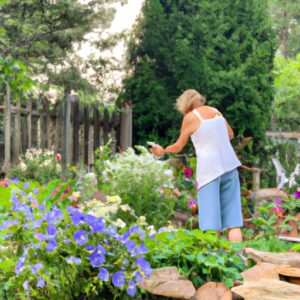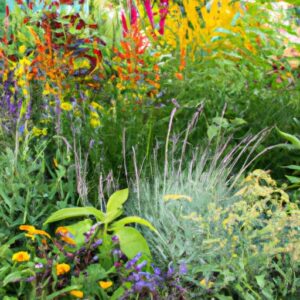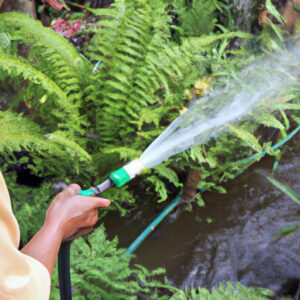Gardening zones are an essential aspect of successful gardening that often goes unnoticed. Have you ever wondered why some plants thrive in certain areas while struggling in others? The secret lies in understanding gardening zones. In this article, we will explore the definition, significance, and everything you need to know about gardening zones.
A. Defining Gardening Zones
Gardening zones, also known as hardiness zones, are geographical regions that classify areas based on their specific climate and temperature conditions. These zones provide valuable information about the types of plants that can flourish in a particular area. By understanding your gardening zone, you can make informed decisions when selecting plants, ensuring they are well-suited to your local climate.
B. The Importance of Understanding Gardening Zones
Understanding gardening zones is crucial for cultivating a thriving garden. It not only helps you choose the right plants but also enables you to plan and maintain your garden effectively. By aligning your plant choices with your gardening zone, you can create an environment conducive to growth, increasing the chances of success and minimizing plant stress.
C. Brief Overview of the Article
In this article, we will delve deeper into the concept of gardening zones. We will explore different gardening zone classifications such as the USDA Hardiness Zones and Sunset Climate Zones, discussing their variations globally. You will learn how to determine your gardening zone, utilizing the available resources and understanding gardening zone maps. Additionally, we will provide tips and considerations for gardening in specific zones, along with recommended plant selections tailored to each zone’s unique characteristics.
Understanding gardening zones allows you to harness the power of nature and create a harmonious garden that thrives effortlessly. So, let’s embark on this gardening journey together and unlock the secrets of gardening zones. By the end of this article, you’ll have the knowledge and confidence to transform your garden into a flourishing oasis.
Understanding Gardening Zones
Gardening zones serve as a vital tool in the realm of gardening, providing valuable insights into the suitability of specific plants for different regions. Let’s delve deeper into the intricacies of gardening zones and explore their significance.
A. Definition and Purpose of Gardening Zones
Gardening zones are geographical areas categorized based on climate and temperature patterns. These zones aim to facilitate successful gardening by guiding gardeners in selecting plants that can thrive in their specific region. By understanding the characteristics of your gardening zone, you can ensure optimal conditions for your plants and enhance their overall health and productivity.
B. Factors Determining Gardening Zones
Several factors contribute to the determination of gardening zones. Climate, temperature, and weather patterns play a crucial role in defining the boundaries of each zone. Factors such as the average minimum temperature, length of growing season, and extreme weather conditions heavily influence the classification of gardening zones. Additionally, geographical features and elevation can also impact the characteristics of a particular zone.
C. Importance of Climate and Temperature in Gardening Zones
Climate and temperature are fundamental elements that significantly affect the success of gardening endeavors. Different plants have specific temperature requirements for germination, growth, and survival. Understanding your gardening zone’s climate and temperature allows you to select plants that are well-suited to those conditions. This knowledge helps you avoid planting species that may struggle or fail due to unsuitable weather conditions, ensuring that your gardening efforts yield fruitful results.
By comprehending the definition, purpose, and factors determining gardening zones, you gain valuable insights into creating an environment conducive to plant growth and prosperity. In the next section, we will explore the various gardening zone classifications and their global variations, enabling you to navigate the world of gardening zones with confidence and finesse.
Different Gardening Zones
A. Overview of Different Gardening Zone Classifications
When it comes to gardening zones, there are various classifications that provide valuable insights into the specific requirements of different regions. Two widely recognized classifications include the USDA Hardiness Zones and the Sunset Climate Zones.
The USDA Hardiness Zones are primarily used in North America and divide the continent into 13 zones based on the average annual minimum temperature. Each zone represents a 10-degree Fahrenheit difference, helping gardeners determine the suitability of plants in their respective areas.
On the other hand, the Sunset Climate Zones take a more comprehensive approach by considering multiple factors, including temperature, elevation, and rainfall patterns. These zones are specifically designed for the western regions of North America, providing gardeners with a detailed understanding of the unique climate conditions in their area.
B. Understanding Global Variations in Gardening Zones
Gardening zones exhibit significant variations globally, influenced by factors such as latitude, altitude, and proximity to large bodies of water. While certain regions may share similar climates, small variations can greatly impact the success of specific plants.
For instance, a plant that thrives in a Mediterranean climate might struggle in a tropical climate, even if both regions are relatively warm. Understanding these global variations is crucial for selecting the right plants and ensuring their survival in your garden.
C. The Importance of Knowing Your Specific Gardening Zone
Knowing your specific gardening zone is paramount for successful gardening. It allows you to choose plants that are inherently adapted to your region’s climate conditions, increasing their chances of survival and growth. By selecting plants that are well-suited to your gardening zone, you can save time, effort, and money, as they require minimal intervention and care.
Moreover, understanding your gardening zone helps you make informed decisions about planting times, watering schedules, and soil amendments. It empowers you to create a customized gardening plan tailored to your specific zone, maximizing the potential of your garden and ensuring optimal results.
Now that we have explored the different gardening zone classifications, as well as the variations in zones across the globe, let’s move on to the next section and discover how to determine your gardening zone accurately.
How to Determine Your Gardening Zone
Understanding your gardening zone is the first step towards creating a successful and thriving garden. By accurately identifying your zone, you can select plants that are best suited to your specific climate. Here are some steps to help you determine your gardening zone:
A. Exploring Resources and Tools to Identify Gardening Zones
Numerous resources and tools are available to assist you in identifying your gardening zone. One popular resource is the USDA Plant Hardiness Zone Map, which divides the United States into different zones based on average minimum winter temperatures. You can access this map online or visit your local agricultural extension office for a physical copy.
Other valuable resources include local gardening clubs, botanical gardens, and nurseries. These organizations often have extensive knowledge of the area’s gardening zones and can provide guidance and recommendations for plant selection.
B. Steps to Determine Your Gardening Zone
Determining your gardening zone is a relatively straightforward process. Here are the steps you can follow:
-
Research: Start by gathering information about your region’s climate and average temperatures throughout the year. This will give you a general idea of the gardening zones prevalent in your area.
-
Consult the USDA Zone Map: Visit the official USDA Plant Hardiness Zone Map website (insert link) and locate your region on the map. The map is color-coded, making it easy to identify your specific zone.
-
Use Zip Code Lookup: Alternatively, you can use the zip code lookup feature on the USDA website. Simply enter your zip code, and it will provide you with the corresponding gardening zone.
-
Seek Local Expertise: If you still have doubts or need further clarification, reach out to local gardening experts, extension offices, or experienced gardeners in your community. They can provide valuable insights and help you determine your gardening zone accurately.
C. Understanding Gardening Zone Maps and Their Relevance
Gardening zone maps are essential tools that visually represent the different gardening zones within a specific region. These maps provide valuable information about temperature ranges and climatic conditions, helping gardeners make informed decisions about plant selection and care.
It’s important to understand that gardening zone maps are not static. They are regularly updated to reflect changes in climate patterns. As a gardener, staying informed about any updates or changes to your gardening zone will ensure you adapt your gardening practices accordingly.
By utilizing available resources, following the steps outlined, and understanding the relevance of gardening zone maps, you can confidently determine your gardening zone. This knowledge will empower you to select plants that thrive in your specific climate, setting the foundation for a vibrant and flourishing garden.
Gardening in Specific Zones
Gardening in specific zones requires careful planning and consideration to ensure optimal plant growth. Each gardening zone comes with its own unique set of challenges and opportunities. In this section, we will explore some valuable tips and considerations for gardening in different zones, recommend suitable plant selections for specific gardening zones, and address the challenges and solutions associated with extreme gardening zones.
A. Tips and Considerations for Gardening in Different Gardening Zones
-
Understanding Your Zone: Familiarize yourself with the characteristics of your specific gardening zone. Take into account factors such as average temperature ranges, frost dates, and soil conditions. This knowledge will guide your plant selection and help you plan your gardening activities accordingly.
-
Choose Zone-Appropriate Plants: Opt for plant varieties that are well-suited to your gardening zone. Consider their tolerance to temperature extremes, moisture requirements, and sunlight needs. By selecting plants that thrive in your zone, you increase the chances of successful growth and reduce the risk of plant stress or failure.
-
Timing is Key: Pay attention to the recommended planting times for your zone. Planting too early or too late can negatively impact the growth and development of your plants. Consult gardening resources or seek advice from local experts to determine the optimal timing for planting various crops and flowers.
B. Recommended Plant Selection for Specific Gardening Zones
-
Cold Climate Zones: In colder regions, consider hardy plants that can withstand frost and lower temperatures. Examples include conifers, winter vegetables like kale and Brussels sprouts, and cold-tolerant flowers such as pansies and snowdrops.
-
Temperate Climate Zones: These zones offer a wide range of plant options. Consider growing popular choices like roses, tomatoes, and a variety of perennial flowers. Research specific plant varieties that thrive in your particular temperate zone for the best results.
-
Hot Climate Zones: In hotter regions, opt for heat-tolerant plants that can withstand intense sunlight and high temperatures. Some suitable options include cacti, succulents, drought-resistant herbs like rosemary, and heat-loving flowers such as sunflowers and zinnias.
C. Challenges and Solutions for Gardening in Extreme Gardening Zones
-
Extreme Cold Zones: In zones with severe cold, protecting plants from frost and ensuring proper insulation is crucial. Consider using frost blankets, mulching techniques, and cold frames to shield plants from freezing temperatures.
-
Extreme Heat Zones: High temperatures can pose challenges for plant growth. Implement shade structures, provide ample water and irrigation, and choose heat-tolerant plants that can withstand the scorching sun. Consider using mulch to conserve soil moisture and reduce heat stress.
By following these tips, selecting appropriate plants, and addressing challenges unique to your gardening zone, you can create a thriving garden that withstands the specific climatic conditions of your area. Gardening in specific zones becomes an enjoyable and rewarding endeavor when armed with the right knowledge and strategies.
Conclusion
In conclusion, gardening zones are the key to unlocking the full potential of your garden. By understanding your gardening zone, you can tailor your plant selections and gardening practices to suit the specific climate and temperature conditions of your area.
Gardening zones provide valuable information that empowers you to make informed decisions about which plants will thrive in your garden. By choosing plants that are well-suited to your gardening zone, you can create an environment where they can flourish, minimizing the risk of failure and maximizing your chances of success.
Throughout this article, we have explored the definition and significance of gardening zones. We have discussed different gardening zone classifications, how to determine your specific gardening zone, and provided tips and considerations for gardening in different zones.
Armed with this knowledge, you can confidently navigate the world of gardening and create a stunning garden that reflects your unique vision. So, embrace the power of gardening zones and let them guide you on your journey to gardening success.
Remember, gardening is a continuous learning process, and understanding your gardening zone is just the beginning. As you delve further into the world of gardening, continue to explore and expand your knowledge. With each season, you will grow as a gardener, nurturing your plants and witnessing the beauty that emerges from the synergy between nature and your efforts.
Now, go forth and create your own garden paradise, where plants thrive, and your love for gardening blossoms. Happy gardening!





